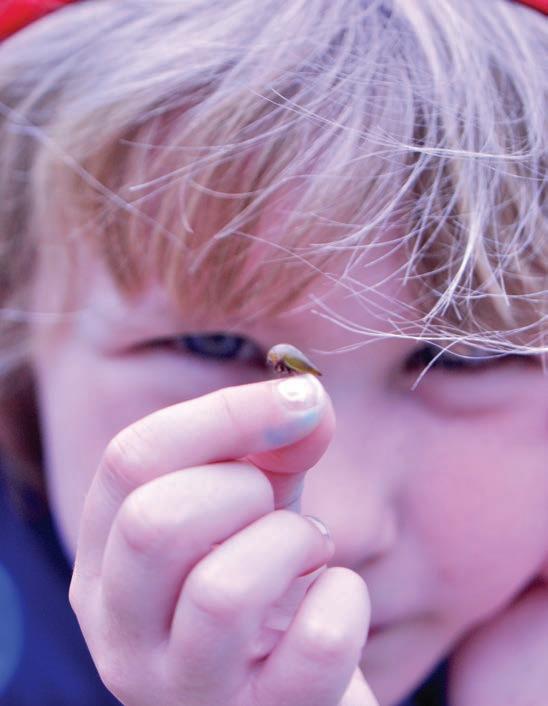
4 minute read
Murray State professor and daughter discovers new species
Murray State professor and daughter discover new species
Story by Simon Placr Photos by Lauren Morgan, Laura Sullivan-Beckers and Robyn Pizzo
Advertisement
On the second floor of the Biology Building, tucked behind a curtain in a laboratory, is a table full of spiders.
Wolf spiders, to be exact, hand-caught by a team of students and professors, brought back to Murray State’s campus to be observed. Their goal is to potentially unlock the secrets of how and why they communicate.
From an early age, Laura Sullivan-Beckers has been interested in sounds, human and animal, and how they’re used to communicate. Her hobbies in high school included birdwatching and studying cassette tapes in various languages: Japanese, Italian and Gaelic. She turned this latter interest into a bachelor’s degree in Spanish, but upon graduating from the University of Tulsa, she realized she didn’t want to be an interpreter or a teacher.
Her love of learning took her to Northeastern State University in Oklahoma, where she pursued a Bachelor of Science in biology with the intention of becoming a park ranger. During her studies, Sullivan-Beckers’ fascination with birds made her decide to take a class in ornithology, and her professor took her to a regional animal behavior conference.
“Students and faculty from schools in our region—Oklahoma, Missouri, Arkansas— would come and present their research at this conference,” Sullivan-Beckers said. “I saw these talks on frog communication and insect communication and I thought ‘Oh my gosh! This is the coolest thing ever!’”
Realizing she could study animal languages like she did human ones, she decided to pursue a doctorate and continue
her research at the University of Missouri, studying treehopper communication. Treehoppers are a species of insects related to cicadas and are found on all continents except Antarctica.
“It became evident that if I wanted to do evolutionary research on animals, it made sense to work with an animal that’s small, reproduces quickly and is easy to maintain in a lab,” Sullivan-Beckers said.
Birding remained an interest—as evidenced by the many books on the subject she keeps on the shelves of her office, and the fact she teaches ornithology at Murray State—but logistically, insects were the way to go. “If you study anything with a backbone, there’s a lot more hoops to jump through, a lot more paperwork,” Sullivan-Beckers said, listing another reason she prefers researching invertebrates. “They’re also just fascinating. People are used to thinking about apes or birds using language, but to think about an insect or a spider…using sophisticated behavior is surprising, I think, to people.”
Sullivan-Beckers decided to make the leap from studying treehoppers to studying spiders in part because she was bothered by a quirk the treehoppers possess.
“When they vibrate you can’t see their bodies move, and you can’t hear them without special equipment,” Sullivan-Beckers said. “If there are three guys on a plant and one of them is singing, I can’t tell you which one it is, and that drove me bananas.”
Spiders, on the other hand, move their whole bodies

to communicate, and this put her troubles with treehoppers to rest.
However, in the summer of 2016, while tending to the family’s backyard garden with her daughter, Sylvie, who was 2 years old at the time, Sullivan-Beckers discovered something curious. Sylvie had overwatered the soil, and small thorn-shaped objects floated to the surface. Upon closer inspection, Sullivan-Beckers found them to be dead treehoppers, like the ones she studied a decade prior for her Ph.D. Noting that it was odd for the tree-dwelling insects to be dead and buried in the soil, Sullivan-Beckers soon began collecting hundreds of samples.
Three years and countless hours of research later, Hebetica sylviae, named for Sylvie, is now on the record as a new species.
“It was crazy,” Sullivan-Beckers said. “My brother still doesn’t buy it. He was like, ‘Laura, when are you gonna come clean and tell the world that you actually planted this treehopper in your backyard? What are the odds that someone who worked on this random group of insects happened to have a new species in her backyard, years later?’ The coincidence is pretty astonishing.”
Sylvie, now 6, spends her days in kindergarten, proud of the fact that she is the only kid in all of Murray with a bug named after her. Her drawings of insects decorate her mom’s office door, and she once went to school dressed as a spider scientist to show everyone what she wants to be when she grows up. She said she wants to help her mom find living specimens of Hebetica sylviae next summer.
“I don’t think she realizes yet [what it means to be on the scientific record],” Laura said. “I wish she could remember the day she made the discovery, but I know she’ll appreciate it when she gets older.”
Laura said the next area she’s interested in researching is the effect of poisonous bugs when they become prey to spiders. She said she noticed a spider she had been observing in her garden had captured a monarch butterfly in its web. The insect’s poison gives them a foul taste, intended to ward off birds, and they are marked with bright orange wings to warn would-be predators. Soon after consuming the butterfly, the spider Laura was observing disappeared, and she said she wonders if the insect was its last meal.
Dan Schoenberg, a graduate biology student, works with Laura as her protégé. He said he’s unsure if he’s made any discoveries new to science in his three semesters at Murray State, but that he enjoys working with Lauras in her spider lab.
“She is a fantastic adviser: patient, hard-working and easy going,” Schoenberg said. “She is always willing to talk about science and will always entertain new ideas.”












